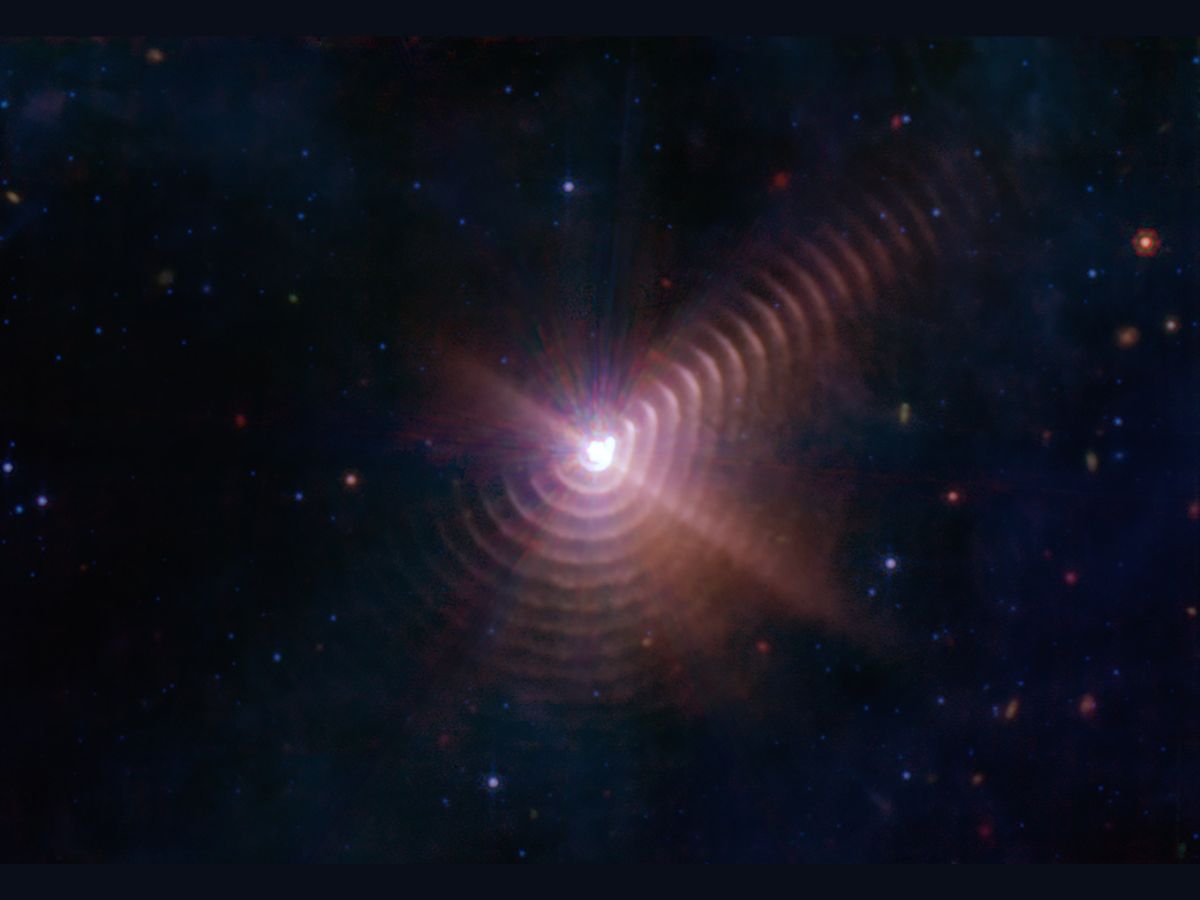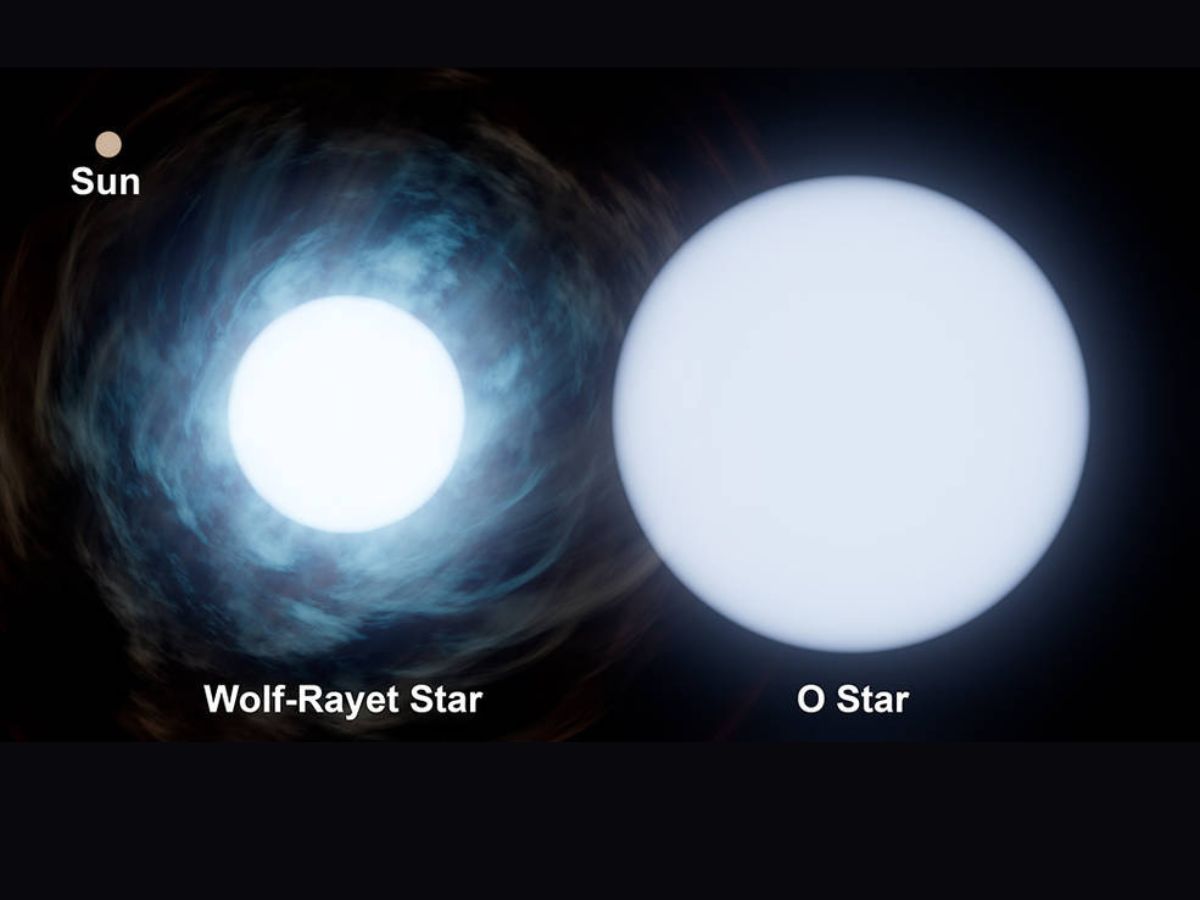In A First, James Webb Space Telescope Captures 'Tree Rings' From Rare Type Of Star System
Webb imaged at least 17 concentric dust rings emanated by a pair of stars known as Wolf-Rayet 140 (WR140). Located over 5,000 light-years from Earth, the star duo forms a 'fingerprint' in space.

NASA's James Webb Space Telescope has once again left the world stunned with its gorgeous images. This time, the JWST, also called Webb, has captured the "tree rings" from a rare type of star system. The telescope imaged at least 17 concentric dust rings emanated by a pair of stars known as Wolf-Rayet 140 (WR140). Located over 5,000 light-years from Earth, the star duo forms a 'fingerprint' in space.
When the two stars come close together and their stellar winds, or streams of gas they blow into space, meet, compressing the gas and forming dust, the rings are created. The orbits of the stars are aligned in a way such that the celestial objects come together about once every eight years. Similar to the growth of rings of a tree's trunk, the dust loops mark the passage of time.
The study describing the findings was recently published in the journal Nature Astronomy.
These cosmic “tree rings” tell a story written by the stars.
— NASA Hallo-Webb Telescope 🕸🕷🎃 (@NASAWebb) October 12, 2022
Every 8 years, these 2 stars are brought together by their orbits, creating streams of gas that can then form a new ring of dust. Webb reveals 15 of the 17 rings here for the first time: https://t.co/k93phPNoec pic.twitter.com/7JHvpsd1A2
Webb's Mid-Infrared Instrument (MIRI) is uniquely qualified to study the dust rings. According to a statement released by NASA, Ryan Lau, the lead author on the paper, and his colleagues, call the dust rings "shells". This is because they are thicker and wider than they appear in the image.
Webb is specialised to detect infrared light, a range of wavelengths the unaided eye is unable to detect. MIRI is able to detect the longest infrared wavelengths, which means it can often see cooler objects, including the dust rings. The dust is formed mostly from material ejected by a type of star known as a Wolf-Rayet star, and MIRI's spectrometer was able to detect the composition of this dust.
What is a Wolf-Rayet star?
A Wolf-Rayet star is an O-type star, which is a bluish-white star with surface temperatures that can range from 25,000 to 50,000 Kelvin. A Wolf-Rayet star is born with at least 25 times more mass than the Sun, and is nearing the end of its life. After it is dead, a Wolf-Rayet star will likely collapse into a black hole.
The star burns hotter during the older stages of its life than when it was younger, and generates powerful winds that push huge amounts of gas into space. The Wolf-Rayet star in Wolf-Rayet 140 may have shed more than half its original mass through the generation of powerful winds.
The star in Wolf-Rayet 140 is surrounded by mysterious concentric rings, which appear like ripples. The ripples gradually fade away, and are not perfectly round. Square-like structures can be seen in the image.
How do Wolf-Rayet stars form concentric rings?
Hydrogen is the most common element found in stars, and cannot form dust on its own. Wolf-Rayet stars also eject more complex elements found deep in the star's interior, including carbon. This is because these stars shed a significant amount of mass.
As the heavy elements travel in space, they cool down, following which they are compressed at the regions where the winds from both stars meet. This is similar to what happens when two hands knead dough, according to NASA.

Wolf-Rayet 140 is unique because of the kinds of rings it makes. Since the orbit of the Wolf-Rayet star in Wolf-Rayet 140 is elongated, and not circular, unlike other Wolf-Rayet stars, a unique ring pattern is formed.
When the stars come close together, about the same distance between Earth and the Sun, and the winds collide, the gas is under sufficient pressure to form dust. The Wolf-Rayet stars which have circular orbits produce dust continuously.
What makes Webb’s image unique?
In a statement released by NASA, Lau said Webb's image reveals over a century of dust production from the Wolf-Rayet star system. He added that the image illustrates how sensitive Webb is. Before Webb started its operations, astronomers were able to see only two dust rings, using ground-based space telescopes. Now, Webb has allowed astronomers to see at least 17 dust rings.
How Wolf-Rayet stars contribute to star formation
According to Lau and his co-authors, WR 140's winds swept the surrounding area of residual matter they might otherwise collide with. As a result, the rings remain so pristine, rather than smeared or dispersed. However, there is a possibility that some rings became smeared or dispersed, something Webb cannot detect.
Though Wolf-Rayet stars seem exotic compared to the Sun, they may have played a role in star and planet formation. An interesting phenomenon occurs when Wolf-Rayet stars clear an area. The material swept up by Wolf-Rayet stars can pile up at the outskirts and become dense enough to form new stars. Some evidence suggests the Sun was formed in a similar manner.

The study used data from MIRI's Medium Resolution Spectroscopy mode to provide the best evidence yet that Wolf-Rayet stars produce carbon-rich dust molecules.
Also, the preservation of the dust shells indicates that the dust can survive in the hostile environment between stars, and eventually supply material for future stars and planets.
How many Wolf-Rayet stars are there in the Milky Way?
Astronomers estimate that the Milky Way galaxy has at least a few thousand Wolf-Rayet stars. However, only about 600 Wolf-Rayet stars have been discovered to date.
Patrick Morris, one of the co-authors on the paper, said even though Wolf-Rayet stars are rare in the Milky Way galaxy because they are short lived, it is possible they have been producing lots of dust throughout the history of the galaxy before they explode or form black holes. He added that with Webb, astronomers will be able to learn a lot more about how these stars shape the material between stars and trigger new star formation in galaxies.
Webb captured the image of Wolf-Rayet 140 in July, 2022. Citizen scientist Judy Schmidt released the image on Twitter in August. However, the peer-reviewed study describing the discovery was published in October.
What other astronomers say about Wolf-Rayet 140
Mark McCaughrean, an interdisciplinary scientist in the James Webb Space Telescope Science Working Group and a science advisor to the European Space Agency (ESA) called the image "bonkers", in a Twitter thread, and said the six-pointed blue structure is an artefact due to the optical diffraction from the bright star in the Webb MIRI (Mid-Infrared Instrument) image. He explained that the "red curvy-yet-boxy stuff" is real, a series of shells around Wolf-Rayet 140, and are actually present in space.
McCaughrean wrote in the same thread that a similar image from the MIRI data already features on the Wikipedia page for Wolf-Rayet 140. He said the image was made by citizen scientist Melina Thévenot.
McCaughrean also explained the probable reason behind the crazy shell structure. He said that Wolf-Rayet stars like Wolf-Rayet 140 are evolved massive stars which have ejected most of their hydrogen envelopes and are fusing helium or have stopped altogether. These stars are very luminous and have huge amounts of dust around them.
The scientist explained that in the case of Wolf-Rayet 140, the dust is being sculpted by dynamical interactions with another star orbiting it. WR112 is a similar system which is surrounded by spiral shells.
The MIRI image has a resolution of approximately 1000 × 1000.
More About Wolf-Rayet 140
Wolf-Rayet 140 is a moderately bright star located in the constellation Cygnus. The Wolf-Rayet star lies in the sky at the centre of the triangle formed by the stars Deneb, Gamma Cygni, and Delta Cygni.
Wolf-Rayet 140 is a variable star, which means it is a star that changes its brightness.
Related Video
Southern Rising Summit 2024: How Important is Self-Awareness? Insights from Anu Aacharya | ABP LIVE








































